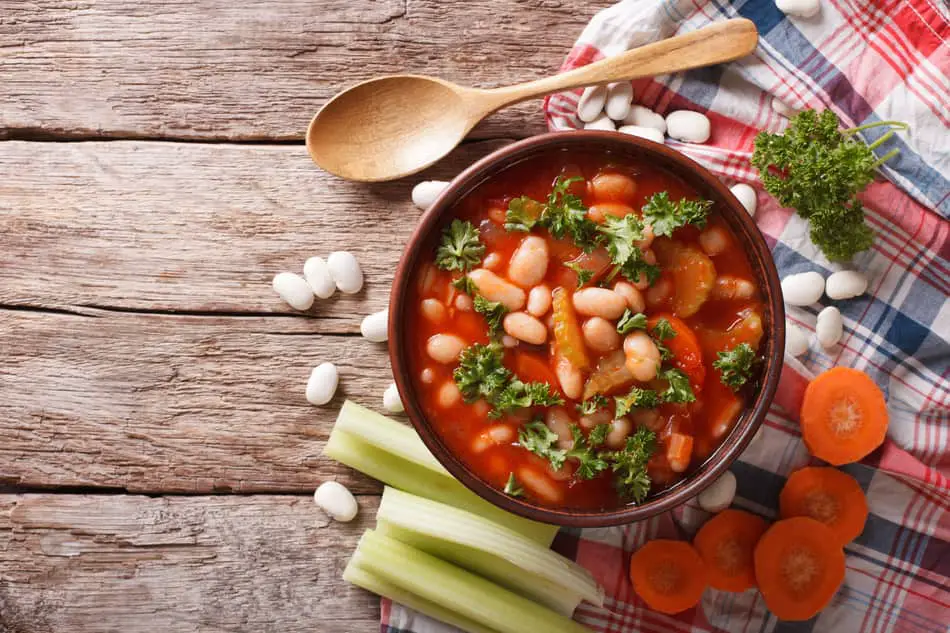
Beans may be nature’s perfect food: they are high in protein, fiber, and other nutrients, and come in relatively low-calorie packages. But many people are trying to eat a low-carb diet. So are beans high in carbs?
The short answer is no, beans are not a high-carb food. Beans are low in total carbs compared to foods like white rice, pasta, and potatoes. They do contain some carbs, however, unlike other high-protein foods such as meat and eggs, which contain negligible carbs. But beans are even lower in carbs when looked at through the lens of net carbs.
Net carbs are the total carbohydrates in a food minus its fiber. Since fiber is not digested, it can be subtracted from the total carb content. The net carb number is a more helpful measure of a food’s impact on your metabolism than the simple carb amount.
Beans are high in fiber; they contain complex carbohydrates. For that reason, all types of beans are low in net carbs.
Another way of stating it is that beans are a low-glycemic food. They do not spike your blood sugar the way that high-carb foods do. See more on this further down.
See my article here for more info on bean nutrition (and how to eliminate gas!).
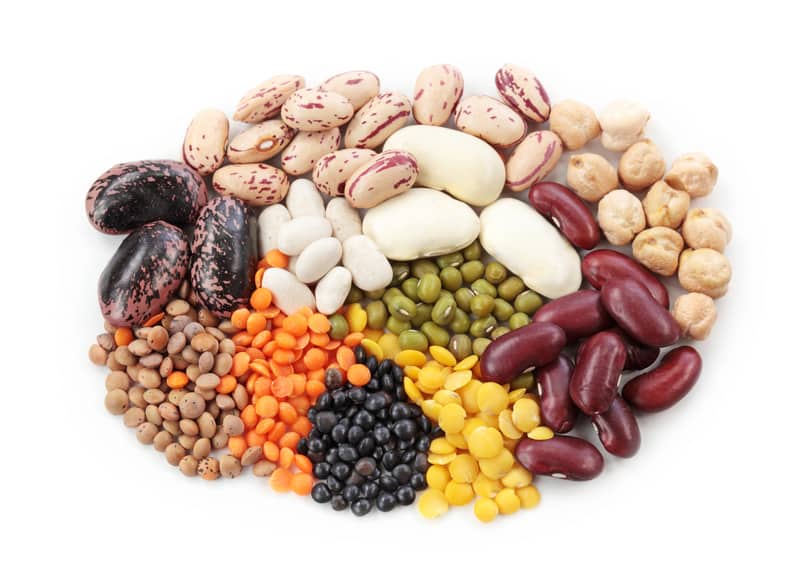
Net Carbs of Beans Compared to Other Foods
Below is a chart comparing a range of foods and their total carbs, fiber, and net carbs, along with what % DV (daily value) of total carbs the food provides.
By the way, “net carbs” is not a legal definition, and is not used by the FDA in its guidance to food manufacturers in creating their nutrition labels. Still, it is widely accepted in the scientific community, and there is agreement that fiber calories are not fully absorbed1.
You may also wonder what the definition of a low-carb food is. The FDA says that 5% of the DV or less of any nutrient can be considered low in that nutrient2. The total carbs in 100 grams of black beans are 6% of the DV, very close to the 5% definition of low carb. Their net carbs are 3.5% of carb DV, so by that measure, black beans are well within the definition of low carb. (Most beans varieties are relatively similar to each other in their carb values; more details below).
A few interesting facts are revealed in the table immediately below:
- Black beans have about half the net carbs of white potatoes.
- Black beans are higher in total carbs than a Granny Smith apple, but lower in net carbs.
- Black beans have more fiber per serving than any other food on this list, including whole what bread.
| Food (100 grams = 1/2-3/4 cup) | Total Carbs (grams) | Fiber (grams) | Net Carbs (grams carbs – fiber) | % DV Carbs (based on total carbs and 275 grams DV) |
| Tofu (firm) | 2.78 | 2.3 | 0.48 | 1.0 |
| Broccoli | 6.27 | 2.4 | 3.87 | 2.3 |
| Carrots (raw) | 9.58 | 2.8 | 6.78 | 3.5 |
| Corn (frozen) | 25.9 | 2.6 | 23.3 | 9.4 |
| Potato (Russet, baked, with skin) | 21.4 | 2.3 | 19.1 | 7.8 |
| Apple (Granny Smith, with skin) | 14.1 | 2.5 | 11.6 | 5.1 |
| Beans (black, canned) | 16.6 | 6.9 | 9.7 | 6.0 |
| White Rice (cooked) | 28.6 | 1 | 20.1 | 10.4 |
| Brown Rice (cooked) | 23.5 | 0.3 | 23.2 | 8.5 |
| Pasta (enriched white flour) | 30.6 | 1.8 | 28.8 | 11.1 |
| Pasta (whole wheat flour) | 30.1 | 3.9 | 26.2 | 10.9 |
| White Bread (commercially prepared) | 49.2 | 2.3 | 46.9 | 17.9 |
| Whole Wheat bread (commercially prepared) | 43.1 | 6 | 37.1 | 15.7 |
| Ruffles potato chips | 53.6 | 3.6 | 50.0 | 19.5 |
Sources:
Glycemic Index/Glycemic Load of Beans Compared to Other Foods
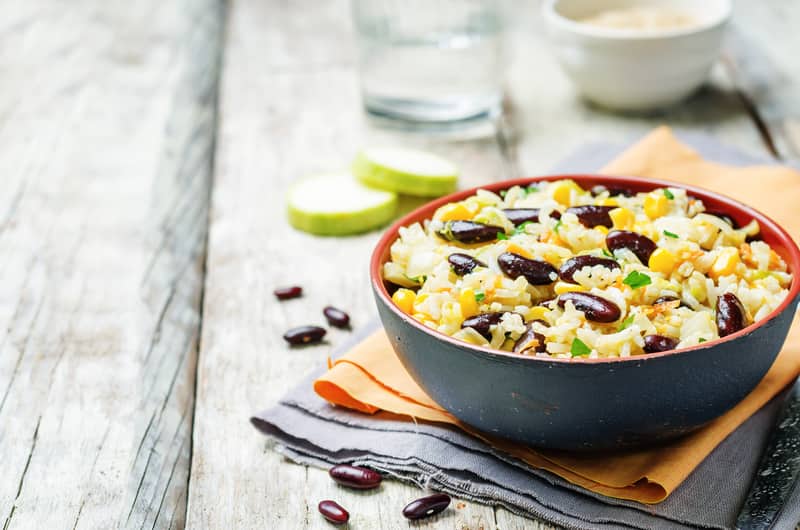
Another way of assessing the carbs in a food is by looking at its glycemic index (GI) and glycemic load (GL). The glycemic index is a measure of how fast a food raises blood glucose compared to reference food like pure glucose. GI levels are classified as3:
- Low: ≤55
- Moderate: 56-69
- High: ≥70
A drawback with the GI index is that it doesn’t take into account other qualities of the food that impact how fast your blood sugar rises. So the glycemic load index was created, which takes into account both quality and quantity of food4. For example, watermelon has a GI of 72 but a GL of only 4 due to its low carb content.
GL is calculated by multiplying a food’s GI by its carbohydrate count and dividing by 100. Like GI, GL can be evaluated based on three ranges5:
- Low: ≤10
- Medium: 11-19
- High: ≥20
Per the chart below, beans are low on the glycemic index and glycemic load index. The average GI of the beans tested is 31, and the average GL is 8.
Other interesting facts revealed in this comparison:
- Most bean varieties have a similar or lower GI than carrots.
- The GI for corn is more than twice as high as the GI for kidney beans. The GL of corn is almost three times as high as for kidney beans.
- The average GL for the beans in this chart is less than half the GL of whole wheat pasta.
| Food | GI* (Glycemic Index) | GL (Glycemic Load) | Serving Size (grams) |
| Tofu (firm) | N/A | N/A | N/A |
| Broccoli | N/A | N/A | N/A |
| Carrots (raw) | 35 | 2 | 80 |
| Corn (sweet) | 62 | 20 | 150 |
| Potato (Russet, baked, with skin) | 69 | 19 | 150 |
| Apple (Golden Delicious) | 39 | 6 | 120 |
| Beans (black, canned) | N/A | N/A | N/A |
| Black-eyed Peas (AKA Cow Peas) | 33 | 10 | 150 |
| Lima Beans (AKA Butterbeans) | 26 | 5 | 150 |
| Garbanzo Beans (AKA Chickpeas) | 36 | 11 | 150 |
| Navy Beans (AKA Small White) | 31 | 9 | 150 |
| Kidney Beans | 29 | 7 | 150 |
| White Rice (cooked) | 72 | 30 | 150 |
| Brown Rice (cooked) | 66 | 21 | 150 |
| Pasta (enriched white flour spaghetti) | 57 | 27 | 180 |
| Pasta (whole wheat flour spaghetti) | 42 | 17 | 180 |
| White Bread (commercially prepared) | 69 | 10 | 30 |
| Whole Wheat bread (commercially prepared) | 72 | 8 | 30 |
| Potato chips | 51 | 12 | 50 |
Source: Atkinson et al6
Note: Standard deviation data were removed from the table for simplicity’s sake.
What About Baked Beans?
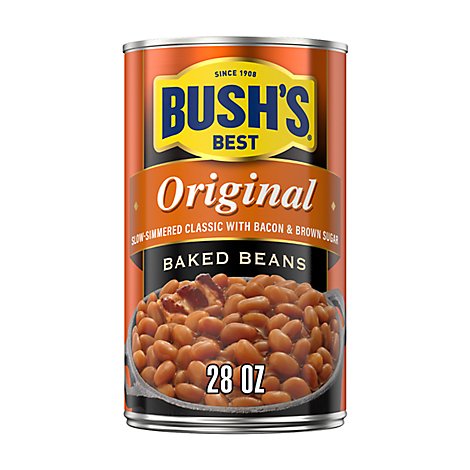
You guessed it, baked beans are not a low-carb food because of the added sugar (or molasses or high-fructose corn syrup, etc.) that goes into baked beans recipes. For example, Bush’s original baked beans contain 30 grams of carbohydrates, which is 11% of the DV. Not as high as pasta or bread, but not meeting the definition of low carb (5% or less of the DV).
Carb Content By Type of Bean
As mentioned, the carb and fiber differences among bean varieties are small. They all range from offering approximately 5-9% of your DV of carbs, and all are in the 2-7% range for fiber. Within these relatively narrow ranges, here are some fun facts about bean varieties and their carb and fiber content:
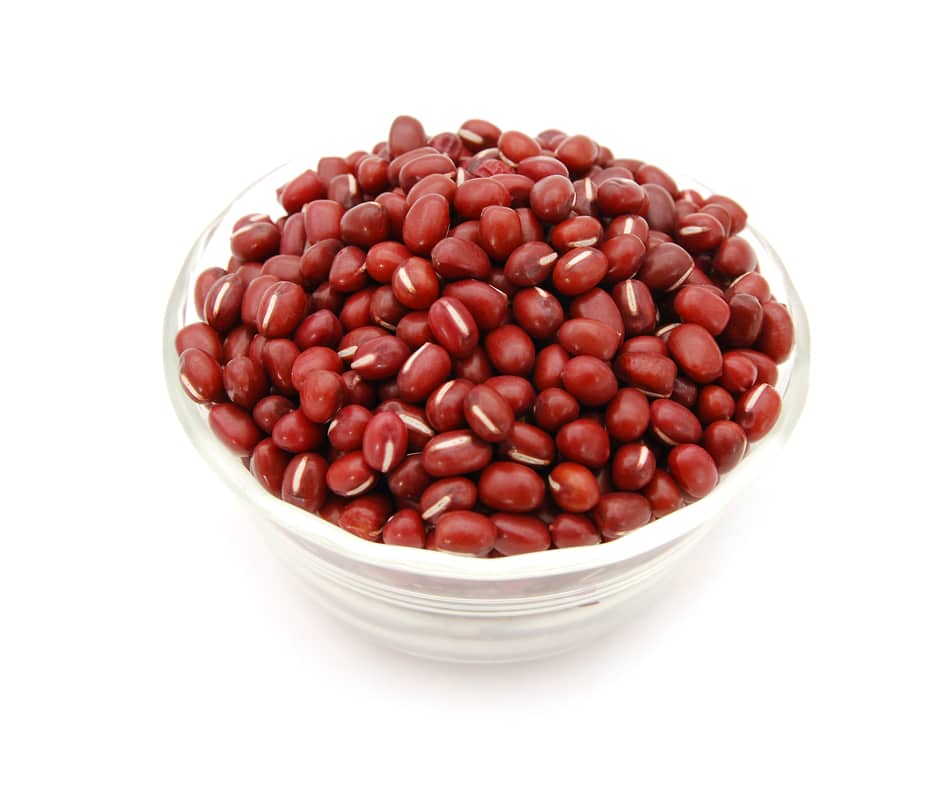
- The highest carb bean is adzuki at 7.3 grams per serving. In my article on the overall nutrition profile of adzuki beans, I considered them perhaps the #1 healthiest bean you can eat (find out why here). White beas have the second-highest amount of fiber, at 16.4 grams, and garbanzo and great northern beans are tied for third place at 16.1 grams each.
- The lowest carb bean is fava at 12.4 grams per serving. Black eyed peas are second-lowest in carbs at 13.1 grams, and kidney beans are the third-lowest in carbs at 14.5 grams.
- Mung beans, a staple in Indian cuisine, are are the bean highest in fiber at 7.3 grams. Adzuki beans are second-highest in fiber at 7.3 grams, and black beans are third-highest at 6.9 grams.
| Bean Variety (100 grams) | Total Carbs (grams) | Fiber (grams) | Net Carbs (grams carbs – fiber) | % DV Carbs (based on total carbs and 275 grams DV) |
| Adzuki* | 24.8 | 7.3 | 17.5 | 9.0 |
| Black (AKA Turtle, Frijoles Negros) | 16.6 | 6.9 | 9.7 | 6.0 |
| Black Eyed Peas** (AKA Cow Peas) | 13.1 | 2.3 | 10.8 | 4.8 |
| Cannellini** (AKA White Kidney, Italian Kidney, Fagioli) | 14.6 | 3.8 | 10.8 | 5.3 |
| Cranberry (AKA Roman, Speckled Sugar, Roman) | 15.1 | 6.3 | 8.8 | 5.5 |
| Fava (AKA Broad) | 12.4 | 3.7 | 8.7 | 4.5 |
| Garbanzo (AKA Chickpeas) | 22.5 | 6.4 | 16.1 | 8.2 |
| Great Northern | 21.0 | 4.9 | 16.1 | 7.6 |
| Kidney (Red) | 14.5 | 4.3 | 10.2 | 5.3 |
| Lima (AKA Butterbeans) | 14.9 | 4.8 | 10.1 | 5.4 |
| Mung | 19.2 | 7.6 | 11.6 | 7.0 |
| Navy (AKA Small White) | 20.4 | 5.1 | 15.3 | 7.4 |
| Pinto | 20.2 | 5.5 | 14.7 | 7.3 |
| Red | 21.5 | 5.5 | 16.0 | 7.8 |
| White | 21.2 | 4.8 | 16.4 | 7.7 |
Notes: Based on 100 grams (about 1/2 cup) of canned, drained beans, except where noted.
* Cooked, drained.
** All data except supplied to the USDA by a manufacturer
Summing It Up
Although beans do contain carbs, they are low in total carbs and even lower in net carbs. There are relatively minor variations in carb amounts among bean types. Beans are also a low glycemic index and low glycemic load food. I personally am not a fan of low-carb diets, as they tend to be low in fiber and other healthful foods like whole grains and fruit. (Although everyone should minimize simple carbs like refined sugar and white flour). But if you are trying to minimize carbs, beans can be a healthful, delicious addition to your diet.
It’s “bean” great working on this post, I hope you found it helpful!
Want a list of the highest fiber, lowest sugar fruit? Get it here.
Curious what the healthiest type of tea is? Find out here.
Is it affordable to be vegan? Get the numbers here.
Resources
Ruffles manufacturer’s website
1 Hervik AK, Svihus B. The Role of Fiber in Energy Balance. J Nutr Metab. 2019;2019:4983657. Published 2019 Jan 21. doi:10.1155/2019/4983657.
3 https://www.gisymbol.com/low-gi-explained/.
4 Eleazu CO. The concept of low glycemic index and glycemic load foods as panacea for type 2 diabetes mellitus; prospects, challenges and solutions. Afr Health Sci. 2016;16(2):468-479. doi:10.4314/ahs.v16i2.15.
5 Walter C Willett, Simin Liu, Carbohydrate quality and health: distilling simple truths from complexity, The American Journal of Clinical Nutrition, Volume 110, Issue 4, October 2019, Pages 803–804, https://doi.org/10.1093/ajcn/nqz215.
6 Fiona S. Atkinson, Kaye Foster-Powell, Jennie C. Brand-Miller; International Tables of Glycemic Index and Glycemic Load Values: 2008. Diabetes Care 1 December 2008; 31 (12): 2281–2283. https://doi.org/10.2337/dc08-1239.
